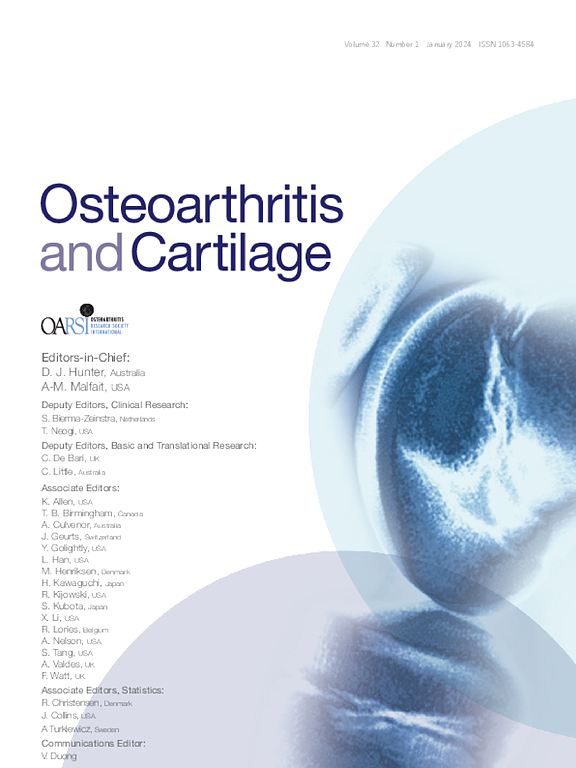专门的促溶解介质maresin 1减轻骨关节炎小鼠模型的疼痛。
IF 7.2
2区 医学
Q1 ORTHOPEDICS
引用次数: 0
摘要
目的:研究特异性促分解分子marsin 1 (MaR1)是否能减轻骨关节炎样疼痛小鼠的伤害性行为。设计:采用关节内注射碘乙酸钠(MIA)诱导oa样疼痛行为,伤后8周腹腔注射MaR1 (N=6)或对照物(N=5)治疗。以未注射MIA的小鼠为对照(N=6)。伤害性行为采用von Frey和动态负重测量法进行检测。免疫荧光染色法检测大鼠背根神经节(DRG) CGRP表达及活化巨噬细胞的变化。通过细胞因子阵列评估循环中的炎症谱。采用钙显像技术评估有或无RAR相关孤儿受体A (RAR相关孤儿受体A)逆激动剂SR3335的有oa样疼痛行为动物DRG神经元对MaR1的体外功能反应。结果:与未治疗小鼠(N=5)相比,MaR1治疗小鼠(N=6)的膝关节疼痛行为减轻,在4小时时,治疗小鼠(N=6)的足部戒断阈值增加,平均差异为112.2% (95% CI [49.79, 174.6], p=0.0784),在MaR1治疗后4天,平均差异为150.9% (95% CI [104.2, 197.5], p=0.0001),在MaR1治疗后1天,体重增加,平均差异为20.08% (95% CI [2.798, 37.37], p=0.0277)。DRG中CGRP表达和活化的巨噬细胞减少,循环中炎症细胞因子水平减弱。钙显像显示MaR1通过RORA降低DRG神经元的功能反应。结论:我们的研究结果表明,MaR1可以减少小鼠OA样疼痛行为,可能是OA疼痛的潜在治疗方法。本文章由计算机程序翻译,如有差异,请以英文原文为准。
Specialized pro-resolving mediator Maresin 1 attenuates pain in a mouse model of osteoarthritis
Objective
We test whether the specialized pro-resolving molecule Maresin 1 (MaR1) attenuates nociceptive behaviors in mice with osteoarthritis-like pain.
Design
Osteoarthritis (OA)-like pain behavior was induced by intra-articular injection of monosodium iodoacetate (MIA) and treated with MaR1 (N=6) or vehicle (N=5) by intraperitoneal injection 8 weeks after injury. Mice without MIA injection were used as control (N=6). Nociceptive behaviors were examined by von Frey and dynamic weight bearing measurements. Calcitonin gene-related peptide (CGRP) expression and activated macrophages in the dorsal root ganglion (DRG) were examined by immunofluorescence staining. The inflammatory profile in circulation was assessed by cytokine array. Calcium imaging was performed to assess the in vitro functional response of DRG neurons from animals with OA-like pain behavior to MaR1 with or without RAR Related Orphan Receptor A (RORA) inverse agonist SR3335.
Results
MaR1 attenuated knee pain behavior in treated mice (N=6) compared to non-treated mice (N=5) as shown by increased paw withdrawal threshold with a mean difference of 112.2% (95% CI [49.79, 174.6], p=0.0784) at 4 h and 150.9% (95% CI [104.2, 197.5], p=0.0001) at 4 days post-MaR1 treatment, and increased weight bearing with a mean difference of 20.08% (95% CI [2.798, 37.37], p=0.0277) at 1 day post-MaR1 treatment. CGRP expression and activated macrophages were decreased in the DRG, and inflammatory cytokine levels in the circulation were attenuated. Calcium imaging showed MaR1 reduced the functional response of DRG neurons through RORA.
Conclusions
Our results show that MaR1 reduces OA-like pain behavior in mice and could be a potential treatment for OA pain.
求助全文
通过发布文献求助,成功后即可免费获取论文全文。
去求助
来源期刊

Osteoarthritis and Cartilage
医学-风湿病学
CiteScore
11.70
自引率
7.10%
发文量
802
审稿时长
52 days
期刊介绍:
Osteoarthritis and Cartilage is the official journal of the Osteoarthritis Research Society International.
It is an international, multidisciplinary journal that disseminates information for the many kinds of specialists and practitioners concerned with osteoarthritis.
 求助内容:
求助内容: 应助结果提醒方式:
应助结果提醒方式:


